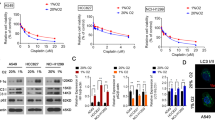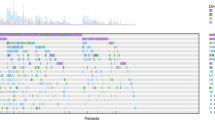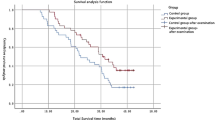Abstract
Aim:
Eukaryotic translation initiation factor 3 subunit A (eIF3a) plays critical roles in regulating the initiation of protein translation, and eIF3a is highly expressed in lung cancer. In this study, we investigated the association of the positively selected SNPs of eIF3a with the response to and toxicity of platinum-based chemotherapy in Chinese patients with non-small cell lung cancer (NSCLC).
Methods:
SNP data for eIF3a locus were downloaded from HapMap database. For each SNP, haplotype, LD profile and population differentiation were analyzed. The long-range haplotype (LRH) test was employed to identify positively selected SNPs of eIF3a. A total of 325 NSCLC patients were enrolled and genotyped for these SNPs.
Results:
Five positively selected (rs1409314, rs4752219, rs4752220, rs7091672 and rs10510050) and 5 non-positively selected SNPs (rs10886342, rs11198804, rs2275112, rs10787899 and rs4752269) were identified in the LRH test. However, none of them was correlated with the platinum-based chemotherapy response. In contrast, 4 of the positively selected SNPs (rs1409314, rs4752219, rs4752220 and rs7091672) were significantly correlated with the toxicities tested (neutropenia, anemia, thrombocytopenia, emesis and hepatotoxicity). In addition, rs10510050 was significantly correlated with thrombocytopenia, emesis and hepatotoxicity. None of the 5 non-positively selected SNPs was correlated with the 5 toxicities.
Conclusion:
The positively selected SNPs of eIF3a are significantly correlated with platinum-based chemotherapy toxicities in Chinese NSCLC patients.
Similar content being viewed by others
Log in or create a free account to read this content
Gain free access to this article, as well as selected content from this journal and more on nature.com
or
References
Sonenberg N, Hershey JWB, Mathews MB . Translational control of gene expression. Cold Spring Harbor (NY): Cold Spring Harbor Laboratory Press; 2000.
Yin JY, Dong Z, Liu ZQ, Zhang JT . Translational control gone awry: a new mechanism of tumorigenesis and novel targets of cancer treatments. Biosci Rep 2011; 31: 1–15.
Dong Z, Zhang JT . Initiation factor eIF3 and regulation of mRNA translation, cell growth, and cancer. Crit Rev Oncol Hematol 2006; 59: 169–80.
Pincheira R, Chen Q, Zhang JT . Identification of a 170-kDa protein over-expressed in lung cancers. Br J Cancer 2001; 84: 1520–7.
Buratti E, Tisminetzky S, Zotti M, Baralle FE . Functional analysis of the interaction between HCV 5'UTR and putative subunits of eukaryotic translation initiation factor eIF3. Nucleic Acids Res 1998; 26: 3179–87.
Yin JY, Dong ZZ, Liu RY, Chen J, Liu ZQ, Zhang JT . Translational regulation of RPA2 via internal ribosomal entry site and by eIF3a. Carcinogenesis 2013; 34: 1224–31.
Yin JY, Shen J, Dong ZZ, Huang Q, Zhong MZ, Feng DY, et al. Effect of eIF3a on response of lung cancer patients to platinum-based chemotherapy by regulating DNA repair. Clin Cancer Res 2011; 17: 4600–9.
Xu X, Han L, Duan L, Zhao Y, Yang H, Zhou B, et al. Association between eIF3alpha polymorphism and severe toxicity caused by platinum-based chemotherapy in non-small cell lung cancer patients. Br J Clin Pharmacol 2013; 75: 516–23.
Xu X, Han L, Yang H, Duan L, Zhou B, Zhao Y, et al. The A/G allele of eIF3a rs3740556 predicts platinum-based chemotherapy resistance in lung cancer patients. Lung Cancer 2013; 79: 65–72.
Tang K, Wong LP, Lee EJ, Chong SS, Lee CG . Genomic evidence for recent positive selection at the human MDR1 gene locus. Hum Mol Genet 2004; 13: 783–97.
Chen X, Wang H, Zhou G, Zhang X, Dong X, Zhi L, et al. Molecular population genetics of human CYP3A locus: signatures of positive selection and implications for evolutionary environmental medicine. Environ Health Perspect 2009; 117: 1541–8.
Ding K, Kullo IJ . Molecular population genetics of PCSK9: a signature of recent positive selection. Pharmacogenet Genomics 2008; 18: 169–79.
Sabeti PC, Reich DE, Higgins JM, Levine HZ, Richter DJ, Schaffner SF, et al. Detecting recent positive selection in the human genome from haplotype structure. Nature 2002; 419: 832–7.
Barrett JC, Fry B, Maller J, Daly MJ . Haploview: analysis and visualization of LD and haplotype maps. Bioinformatics 2005; 21: 263–5.
Lewontin RC . Annotation: the analysis of variance and the analysis of causes. Am J Hum Genet 1974; 26: 400–11.
Excoffier L, Lischer HE . Arlequin suite ver 3.5: a new series of programs to perform population genetics analyses under Linux and Windows. Mol Ecol Resour 2010; 10: 564–7.
Schulze TG, Chen YS, Akula N, Hennessy K, Badner JA, McInnis MG, et al. Can long-range microsatellite data be used to predict short-range linkage disequilibrium. Hum Mol Genet 2002; 11: 1363–72.
Stephens M, Smith NJ, Donnelly P . A new statistical method for haplotype reconstruction from population data. Am J Hum Genet 2001; 68: 978–89.
JG FSTAT, a program to estimate and test gene diversities and fixation indices (version2.9.3). Available from http://www.unil.ch/izea/softwares/fstat.html. Updated from Goudet (1995). 2001.
Purcell S, Neale B, Todd-Brown K, Thomas L, Ferreira MA, Bender D, et al. PLINK: a tool set for whole-genome association and population-based linkage analyses. Am J Hum Genet 2007; 81: 559–75.
International HapMap Consortium. The International HapMap Project. Nature 2003; 426: 789–96.
Akey JM, Zhang G, Zhang K, Jin L, Shriver MD . Interrogating a high-density SNP map for signatures of natural selection. Genome Res 2002; 12: 1805–14.
Rosenberg NA, Pritchard JK, Weber JL, Cann HM, Kidd KK, Zhivotovsky LA, et al. Genetic structure of human populations. Science 2002; 298: 2381–5.
Biswas S, Akey JM . Genomic insights into positive selection. Trends Genet 2006; 22: 437–46.
Bamshad M, Wooding SP . Signatures of natural selection in the human genome. Nat Rev Genet 2003; 4: 99–111.
Wang Z, Wang J, Tantoso E, Wang B, Tai AY, Ooi LL, et al. Signatures of recent positive selection at the ATP-binding cassette drug transporter superfamily gene loci. Hum Mol Genet 2007; 16: 1367–80.
Li XP, Yin JY, Wang Y, He H, Li X, Gong WJ, et al. The ATP7B genetic polymorphisms predict clinical outcome to platinum-based chemotherapy in lung cancer patients. Tumour Biol 2014; 35: 8259–65.
Wang Y, Yin JY, Li XP, Chen J, Qian CY, Zheng Y, et al. The association of transporter genes polymorphisms and lung cancer chemotherapy response. PLoS One 2014; 9: e91967.
Wang Y, Li XP, Yin JY, Zhang Y, He H, Qian CY, et al. Association of HMGB1 and HMGB2 genetic polymorphisms with lung cancer chemotherapy response. Clin Exp Pharmacol Physiol 2014; 41: 408–15.
Chaudhuri J, Chakrabarti A, Maitra U . Biochemical characterization of mammalian translation initiation factor 3 (eIF3). Molecular cloning reveals that p110 subunit is the mammalian homologue of Saccharomyces cerevisiae protein Prt1. J Biol Chem 1997; 272: 30975–83.
Olson JE, Wang X, Goode EL, Pankratz VS, Fredericksen ZS, Vierkant RA, et al. Variation in genes required for normal mitosis and risk of breast cancer. Breast Cancer Res Treat 2010; 119: 423–30.
Acknowledgements
This work was supported by National High-tech R&D Program of China (863 Program Grant, No 2012AA02A517 and 2012AA02A518), National Natural Science Foundation of China (No 81173129, 81202595, 81373490, and 81273595), and Hunan Provincial Natural Science Foundation of China (No 2015JJ1024).
Author information
Authors and Affiliations
Corresponding authors
Additional information
(Supplementary Tables and Figures are available at the Acta Pharmacologica Sinica's website.
Supplementary information
Supplementary Information, Figure S1
Flow chart of SNPs selection. (JPG 761 kb)
Supplementary Information, Figure S2
Proportion of SNP pairs with significant LD in the populations. (JPG 272 kb)
Supplementary Information, Figure S3
FST plot of the eIF3a SNPs. (JPG 166 kb)
Supplementary Information, Figure S4
EHH analysis of 5 positive selected SNPs polymorphisms. (JPG 342 kb)
Supplementary Information, Figure S5
HBD for 5 positive selected SNPs in ASN, CEU and YRI populations. (JPG 2515 kb)
Supplementary Information, Table S1
Selected characterizations of involved SNPs. (DOC 179 kb)
Rights and permissions
About this article
Cite this article
Yin, Jy., Meng, Xg., Qian, Cy. et al. Association of positively selected eIF3a polymorphisms with toxicity of platinum-based chemotherapy in NSCLC patients. Acta Pharmacol Sin 36, 375–384 (2015). https://doi.org/10.1038/aps.2014.160
Received:
Accepted:
Published:
Issue date:
DOI: https://doi.org/10.1038/aps.2014.160
Keywords
This article is cited by
-
Down-regulation of MSH3 and MSH6 genes in female breast cancer patients receiving taxane-based therapy
Future Journal of Pharmaceutical Sciences (2023)
-
Gene-gene and gene-environment interaction data for platinum-based chemotherapy in non-small cell lung cancer
Scientific Data (2018)
-
Association between DNA mismatch repair gene polymorphisms and platinum-based chemotherapy toxicity in non-small cell lung cancer patients
Chinese Journal of Cancer (2017)
-
Gene-gene and gene-environment interactions influence platinum-based chemotherapy response and toxicity in non-small cell lung cancer patients
Scientific Reports (2017)
-
Associations of genetic polymorphisms of the transporters organic cation transporter 2 (OCT2), multidrug and toxin extrusion 1 (MATE1), and ATP-binding cassette subfamily C member 2 (ABCC2) with platinum-based chemotherapy response and toxicity in non-small cell lung cancer patients
Chinese Journal of Cancer (2016)



